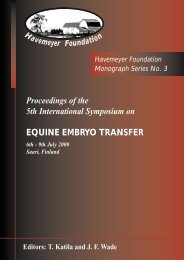Proceedings of a Workshop on - The Havemeyer Foundation
Proceedings of a Workshop on - The Havemeyer Foundation
Proceedings of a Workshop on - The Havemeyer Foundation
You also want an ePaper? Increase the reach of your titles
YUMPU automatically turns print PDFs into web optimized ePapers that Google loves.
<strong>Havemeyer</strong> Foundati<strong>on</strong> M<strong>on</strong>ograph Series No. 11<br />
laryngeal paralysis. Older pet dogs with unilateral<br />
laryngeal paralysis are seldom presented with<br />
clinical signs but working or racing dogs with<br />
unilateral paralysis may present with clinical signs<br />
that interfere with their work (Greenfield 1987).<br />
Greenfield et al. (1997) showed that clinical<br />
signs and measurable airflow changes associated<br />
with bilateral laryngeal paralysis did not develop in<br />
dogs until a median <str<strong>on</strong>g>of</str<strong>on</strong>g> 38 days following bilateral<br />
denervati<strong>on</strong> <str<strong>on</strong>g>of</str<strong>on</strong>g> the recurrent laryngeal nerves. <strong>The</strong><br />
reas<strong>on</strong> for such a delay is unclear. It has been<br />
suggested that slow development <str<strong>on</strong>g>of</str<strong>on</strong>g> clinical signs in<br />
many naturally occurring cases <str<strong>on</strong>g>of</str<strong>on</strong>g> canine idiopathic<br />
laryngeal paralysis is due to progressive<br />
deteriorati<strong>on</strong> <str<strong>on</strong>g>of</str<strong>on</strong>g> the recurrent laryngeal nerve.<br />
However, progressive anatomical changes in the<br />
laryngeal structures may also be necessary for<br />
development <str<strong>on</strong>g>of</str<strong>on</strong>g> severe clinical signs.<br />
Canine idiopathic laryngeal paralysis can be<br />
c<strong>on</strong>firmed by ultras<strong>on</strong>ography in the c<strong>on</strong>scious<br />
dog or laryngoscopy in the lightly anaesthetised<br />
subject (deeper anaesthesia will cause immobility<br />
<str<strong>on</strong>g>of</str<strong>on</strong>g> even the normal larynx), taking care to<br />
distinguish passive laryngeal abducti<strong>on</strong> associated<br />
with deep expirati<strong>on</strong> from normal active laryngeal<br />
abducti<strong>on</strong> that occurs during inspirati<strong>on</strong>.<br />
Most publicati<strong>on</strong>s <strong>on</strong> idiopathic canine<br />
laryngeal paralysis report the diagnosis and<br />
treatment <str<strong>on</strong>g>of</str<strong>on</strong>g> this disorder, or the use <str<strong>on</strong>g>of</str<strong>on</strong>g> dogs as<br />
models to treat human laryngeal paralysis. Few<br />
comment <strong>on</strong> the pathogenesis or epidemiology.<br />
Early work suggested involvement <str<strong>on</strong>g>of</str<strong>on</strong>g> a neurogenic<br />
or denervati<strong>on</strong> atrophy <str<strong>on</strong>g>of</str<strong>on</strong>g> the laryngeal muscles<br />
(such as occurs in horses) and this has become<br />
widely accepted as the most likely aetiopathogenesis<br />
(O’Brien et al. 1973). Most studies have either used<br />
retrospective case analysis (O’Brien et al. 1973);<br />
have been restricted to c<strong>on</strong>genital laryngeal<br />
paralysis (van Haagen et al. 1978, 1981) or have<br />
analysed laryngeal innervati<strong>on</strong> in normal dogs<br />
(Braund et al. 1988 a,b), and so their data and<br />
c<strong>on</strong>clusi<strong>on</strong>s can be difficult to extrapolate to<br />
idiopathic canine laryngeal paralysis. For example,<br />
van Haagen et al. (1978, 1981) have described<br />
histological evidence <str<strong>on</strong>g>of</str<strong>on</strong>g> neurogenic ax<strong>on</strong>al<br />
degenerati<strong>on</strong> <str<strong>on</strong>g>of</str<strong>on</strong>g> the right and left recurrent laryngeal<br />
nerves in cases <str<strong>on</strong>g>of</str<strong>on</strong>g> c<strong>on</strong>genital laryngeal paralysis<br />
Biopsies <str<strong>on</strong>g>of</str<strong>on</strong>g> intrinsic laryngeal muscles in cases<br />
<str<strong>on</strong>g>of</str<strong>on</strong>g> idiopathic canine laryngeal paralysis have shown<br />
evidence <str<strong>on</strong>g>of</str<strong>on</strong>g> neurogenic atrophy (O’Brien et al.<br />
1973; Love et al. 1987). A comparative study <str<strong>on</strong>g>of</str<strong>on</strong>g> the<br />
neuropathology <str<strong>on</strong>g>of</str<strong>on</strong>g> canine and equine ‘RLN’ could<br />
provide much useful informati<strong>on</strong> for both species.<br />
REFERENCES<br />
Braund, K.G., Steiss, J.E., Marshall A.E., Mehta, J.G.,<br />
Toivio-Kinnucan, M. and Amling, K.A. (1988a)<br />
Morphologic and morphometric studies <str<strong>on</strong>g>of</str<strong>on</strong>g> the vagus<br />
and recurrent laryngeal nerves in clinically normal<br />
adult dogs. Am. J. vet. Res. 49, 2111-2116.<br />
Braund, K.G., Steiss, J.E., Marshall A.E., Mehta, J.R.<br />
and Amling, K.A. (1988b) Morphologic and<br />
morphometric studies <str<strong>on</strong>g>of</str<strong>on</strong>g> the intrinsic laryngeal<br />
muscles in clinically normal adult dogs. Am. J. vet.<br />
Res. 49, 2105-2110.<br />
Braund, K.G., Steinberg, H.S., Shores, A., Steiss, J.E.,<br />
Mehta, J.G., Toivio-Kinnucan, M. and Amling, K.A.<br />
(1989) Laryngeal paralysis in immature and mature<br />
dogs as <strong>on</strong>e sign <str<strong>on</strong>g>of</str<strong>on</strong>g> a more diffuse polyneuropathy.<br />
J. Am. vet. med. Ass. 12, 1735-1740.<br />
Braund, K.G., Shores, A., Cochrane, S., Forester, D.,<br />
Kwicien, J.M. and Steiss, J.E. (1994) Laryngeal<br />
paralysis-polyneuropathy complex in young<br />
Dalmati<strong>on</strong>s. Am. J. vet. Res. 55, 534-542.<br />
Broome, C., Burbidge, H.M. and Pfeiffer, D.U. (2000)<br />
Prevalence <str<strong>on</strong>g>of</str<strong>on</strong>g> laryngeal paresis in dogs undergoing<br />
general anaesthesia. Aust. vet. J. 78, 769-772.<br />
Burbidge, H.M., Goulden, B.E. and J<strong>on</strong>es, B.R. (1993)<br />
Laryngeal paralysis in dogs: an evaluati<strong>on</strong> <str<strong>on</strong>g>of</str<strong>on</strong>g> the<br />
bilateral arytenoid lateralisati<strong>on</strong> procedure. J. small<br />
Anim. Pract. 34, 515-519.<br />
Gaber C.E., Amis, T.C., LeCouteur, R.A. (1985)<br />
Laryngeal paralysis in dogs: A review <str<strong>on</strong>g>of</str<strong>on</strong>g> 23 cases. J.<br />
Am. vet. med. Ass. 186, 377-380.<br />
Greenfield, C.L. (1987) Canine laryngeal paralysis.<br />
Comp. c<strong>on</strong>t. Educ. pract. Vet. 9, 1011-1020.<br />
Greenfield, C.L., Alsup, J.C., Hungerford, L.L. and<br />
McKiernan B.C. (1997) Bilateral recurrent<br />
laryngeal neurectomy as a model for the study <str<strong>on</strong>g>of</str<strong>on</strong>g><br />
idiopathic canine laryngeal paralysis. Can. vet. J.<br />
38, 163-167.<br />
Mah<strong>on</strong>y, O.M., Knowles, K.E., Braund, K.G., Averill,<br />
D.G. and Frimbeerger, A.E. (1998) Laryngeal<br />
paralysis-polyneuropathy complex in young<br />
Rottweilers. JVIM 12, 330-337.<br />
Love, S., Waterman, A.E. and Lane, J.G (1987) <strong>The</strong><br />
assessment <str<strong>on</strong>g>of</str<strong>on</strong>g> corrective surgery for canine<br />
laryngeal paralysis by blood-gas analysis – a review<br />
<str<strong>on</strong>g>of</str<strong>on</strong>g> 35 cases. J. small Anim. Pract. 28, 597-604.<br />
O’Brien, J.A., Harvey, C.E., Kelly, A.M. and Tucker,<br />
J.A. (1973). Neurogenic atrophy <str<strong>on</strong>g>of</str<strong>on</strong>g> the laryngeal<br />
muscles <str<strong>on</strong>g>of</str<strong>on</strong>g> the dog. J. small Anim. Pract. 14, 551-<br />
532.<br />
Ridyard, A.E., Corcoran, B.M., Tasker, S., Willis, R.,<br />
Welsh, E.M. Demetriou, J.L. and Griffiths, L.G.<br />
(2000) Sp<strong>on</strong>taneous laryngeal paralysis in four<br />
white-coated German shepherd dogs. J. small Anim.<br />
Pract. 41, 558-561.<br />
van Haagen, A.J., Hartmann, W. and Goedegebuure, S.A.<br />
(1978) Sp<strong>on</strong>taneous laryngeal paralysis in young<br />
Bouviers. J. Am. anim. Hosp. Ass. 14, 714-720.<br />
van Haagen, A.J., Bouw, J. and Hartman, W. (1981)<br />
Hereditary transmissi<strong>on</strong> <str<strong>on</strong>g>of</str<strong>on</strong>g> laryngeal paralysis in<br />
Bouviers. J. Am. anim. Hosp. Ass. 17, 75-76.<br />
17








